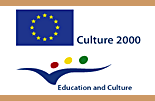
|
Jarmila Kaczmarek,
Andrzej Prinke
(Poznań Archaeological Museum)
Archaeology misused:
Polish-German dialogue in Greater Poland
in the period of developing
nationalisms (1920-1956)
|
In
the Polish language there are a few words related to the concept
of nation that are similar in form but different in meaning. These
words are as follows: "naród" - nation, "narodowość" - nationality,
"nacja" - old-fashioned for nation and "nacjonalizm" - nationalism.
Naród is a separated ethnic community that is often organized
in a state; naród is actually identical with the old Polish nacja
of a Latin origin. The related narodowość is also a separated
ethnic community, it does not however need to be a sovereign state.
Love towards one's own country, towards the big state but also
towards the small local fatherland is called patriotyzm - patriotism.
The word nacjonalizm - nationalism has already a pejorative meaning
and is understood as a degenerated form of patriotism. We refer
to nationalism when an exceptional attention is paid to the nationality,
superiority of a nation's interest is indicated over the interest
of an individual or any other social group. Chauvinism is an extreme
form of nationalism in which uncritical admiration of one's own
nation is accompanied by a conviction of its superiority over
any other nations and by hostility towards them (Nowa Encyklopedia
Powszechna PWN 1996, p. 201).
Elaborating on nationalism,
that is on deformed patriotism, is extremely challenging, as it
is often impossible to spot the borderline separating cases where
it is still permissible to speak about the fight for just rights
from cases where speaking about just rights has already chauvinistic
grounds. Separating patriotism from nationalism is especially
difficult in instances when an ethnic group is incorporated into
a foreign state against its will, it is oppressed by that state,
sometimes even exterminated, and the property of this ethnic group's
members are transferred to members of some other ethnic group
without any observance of their rights. How long are people allowed
to feel hurt and miss after or for their Promised Land? What should
be done if an ethnic group settles in a cradle of some state,
grows bigger and stronger and after some time starts to demand
e.g. sovereignty for themselves? These are issues that have not
been answered so far. |
| 1. Political conditioning
|
| 1.1. Greater Poland under the rule of the
King of Prussia |
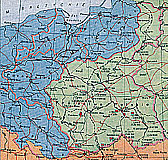
fig. 1 |
In
order to understand the merits of the Polish-German conflict in
years 1920-1956, one will need to go slightly back in time. In
the end of the 18 th century Poland was partitioned by three neighboring
countries. Greater Poland (or: Wielkopolska) became a part of
Prussia ( fig. 1). From that moment on
Poles became a national minority in the Prussian state, being
subject to increasing discrimination and trials of denationalization.
It is Germans that were privileged in Greater Poland,
supported in the 19 th century by the |
| Prussian state by means of financial subsidies
and developing education system, building temples, rendering offices
available, creating chances of promotion in the army. The group
of Germans was soon joined by the Greater Poland's Jews, who quickly
surrendered to Germanization. The Poles from the Prussian partition
were left alone in coping with this difficult situation, and so
they handled the matters of economics and social life, but also
organized secret lessons of writing and reading in the mother
tongue (from year 1901). Because it was a nationality and not
an individual social group that was oppressed, the Poles consolidated,
and the up till then poorly developed national consciousness of
the Polish peasantry found its firm grounds.
On the turn of the 19th
century according to Greater Poles, a decent Pole was someone
who felt Polish, did not surrender himself nor his family to Germanization,
had a job and worked in an honest manner, remained sober and economical,
purchased goods mainly from other Poles and thus supported the
home economics, was a Catholic tied closely to his family and
participated actively in Polish social organizations. Such an
understanding was accompanied by ill-will towards Germans and
Jews who were perceived as oppressors, which was not unjustified,
but certainly not in all cases.
On the other hand there
was an ideal German living in Wielkopolska Province that was seen
by German authorities as a Prussian subject who supported policies
of the authorities, was a Protestant (possibly of Jewish faith),
down to earth, surpassing Poles in terms of behavior and education
as well as managerial abilities, a person actively engaged in
Germanizing the country, participating in German organizations
and avoiding any closer relations with Poles. Naturally, both
representations were often only wishful thinking that had little
in common with the reality.
By the mid-eighties
of the 19th century ancient artifacts were generally considered
to be traces from the Polish past - in the sense of today's cultural
heritage of a given country. When in 1885 Bismarck, the Prussian
chancellor commissioned a supervisor of the Bydgoszcz province
to draw up a plan for accelerated Germanization of Greater Poland,
the later, apart from setting up the Colonization Commission,
pointed to the German inhabitants feeling strange. In reaction
to this statement antiquity historians and archaeologists "Germanized"
the province's past, convincing Germans into believing that their
ancestors had inhabited the territory for ages. They referred
to written sources, particularly by ancient authors, especially
Tacitus, Jordanes and Plinius. Interpretations of vague data provided
by Tacitus as alleged evidence of German ancestors being settled
in Greater Poland met with protests of local Poles, too weak however
to be convincing - there were no professional prehistorians in
the region. |
| 1.2. Polish case during the World War One |
For
Europe, and particularly its central, eastern and partly southern
parts, World War I caused by Austio-Hungary supported by Prussia,
Bulgaria and Turkey (the central powers) brought by significant
political changes. Foremost the Austrio-Hungarian Empire was dissolved
and instead a number of national countries were established. Moreover
the Russian Tsardom was abolished and in its place a multinational
Bolshevik state was brought into existence. Also Poland regained
its independence. Already the outbreak of the war made the Prussian
authorities as well as the Germans living in Greater Poland gradually
change their approach towards Poles so they would not decide to
support the anti-German alliance. It was extremely crucial because
in all three partitioning armies over half a million of soldiers
were Polish. Naturally both sides of the conflict counted on Poles
participating in their armies, therefore during the war a number
of declarations were issued on establishing an independent Polish
state in the future. On November 5, 1916 the central powers called
into existence the satellite Polish Kingdom out of a part of the
Polish territory annexed by Russia. On January 22, 1917, United
States President Woodrow Wilson proclaimed the right of national
sovereignty and in his address he called for erecting a "united,
independent and self-contained" Polish state. The Poles right
of sovereign country was recognized also by Russia, and it is
both by the Petrograd Council of Workmen's Delegates (March 27,
1917) and by the Temporary Government (March 30, 1917). Germans
however put their efforts so that the possible reconstruction
of Poland would not be at the cost of Prussia. In the end of 1918
in Poznań the Commission of German Unions issued the leaflet "Wohin
gehört Posen?" (Where does Poznań belong to?) that read: "The
Poznań Province is not a Polish piece of land but a country of
German culture and customs. (...) It belongs to Germany in terms
of economics and strategy." In November 1918 Ostmarkverein (Hakata)
also made an address calling for cooperation of all Germans, "so
that our old German eastern boundaries remain with the German
nation, so that the local Germans are saved from foreign governments"
(Grześ, Kozłowski, Kramski 1976, pp. 274-277, 300-301, 363). On
November 11, 1918 the truce convention was signed and Greater
Poland remained within the borders of Germany (Grześ, Kozłowski,
Kramski 1976, p. 379), however on the turn of 1918 Poles living
in Greater Poland rose up in arms and succeeded in the fight for
freedom by force of arms. |
| 1.3. Province of Greater Poland after the
World War One |
The
Versailles Treaty settled down that the bigger part of Greater
Poland was included in the Polish state. Poles, Germans and Jews
were free to choose their citizenship, and also Germans and Jews
could return without any restrictions to Germany and sell their
real estates directly or using some help from Poland. On April
30, 1919 the Polish provincial authorities in Poznań officially
assured the German inhabitants of Greater Poland about full equality
of rights, freedom of religion and beliefs, access to state offices,
freedom to maintain and develop the German language and national
culture and protection of property (Grześ, Kozłowski, Kramski
1976, pp. 418-419). These solutions were not satisfactory to anyone.
Whereas in 1919 in Poznań
was inhabited by Germans and Jews in 42% (the Jews alone constituted
app. 5,1%), in 1921 the two nationalities constituted only 5,5%
of all inhabitants (Jakóbczyk 1998, pp. 798, 944). Although the
Germans who decided to stay enjoyed liberties they had never awarded
to Poles, they lost former privileges and became citizens not
different from Poles, had to learn the despised Polish language
to be able to communicate in offices and while travelling to Berlin,
they needed passports. Therefore they called Poland a "season
country" and demanded the borders be revised according to the
state as of year 1914.
Neither the Polish habitants
of Wielkopolska Province were satisfied with the state of facts.
They dismissed the idea that vast lands settled by the Polish
majority were allowed to Germany, and this not only in Greater
Poland, but also in Upper Silesia, all the more because the liberties
awarded to Germans in Poland were not governed by the rule of
mutuality. Any movements in that respect met with minimal reaction
of the government in Warsaw. A classic example of carelessness
about the Polish interests in the West sides is a village Kalina
in the Piła region that under the Versailles Treaty was awarded
to Poland and that was sold to Germany by the government of Poland
for 50 thousand Marks (Grześ, Kozłowski, Kramski 1976, p. 425). |
| 2.1. Beginnings of the archaeological institutions
in Greater Poland |
As
of 1919 some grounds of Polish institutional archaeology were
being laid down. At that time Polish conservation services and
university departments were established and the museum management
was adjusted for changed conditions. The interwar period was however
a challenging time for the state and the society. Attempts to
merge the three parts of Poland from under the partition were
not easy. Frictions could be observed between diverse interests
and traditions, which were equally visible in the archaeology. |
In
Poznań the new order in archaeology was organized foremost by
Józef Kostrzewski ( fig. 2). He was a typical
"citizen of Greater Poland", a remarkable organizer used to creating
necessary work tools without waiting for any official ordinances
but hoping for settling the formalities later in the future. For
Józef Kostrzewski the first years after World War I were the time
of organizing and putting the prehistory in Poznań in order, and
in the science in general the time of cultural systematizing of
the Polish territories. In 1919 in Poznań there were
two museums with their archeological
|

fig. 2 |
collections: the Polish ( fig.
3), established in 1857 (in future Mielżynski Family Museum)
and the Wielkopolskie Museum (founded in 1894 as a German Provinzialmuseum,
and in 1904 renamed as Kaiser Friedrich Museum - fig.
4). The existence of two museums made sense as long as Greater
Poland was a part of Prussia. After 1919 operations were carried
out for combining the two collections which was finally achieved
in 1924 as a new autonomous Prehistoric Department of the Wielkopolskie
Museum was founded under the management of Józef Kostrzewski.
At the same time Kostrzewski was one of the Poznań University
founders, where starting of 1919 he took over the prehistoric
department. Also the post of the prehistoric monuments conservator
was established this year held in Greater Poland during the entire
interwar period by Zygmunt Zakrzewski. Moreover in 1920 in Poznań
Kostrzewski called the Polish Prehistoric Society into existence. |
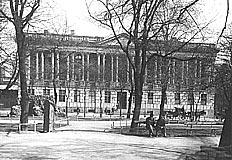
fig. 3 |
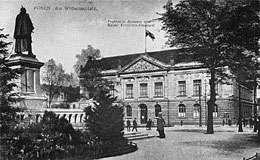
fig. 4 |
| 2.2.1. Archaeological culture or ethnos? Two
sides of the barricade |
Józef
Kostrzewski quite quickly realized that method of identifying
culture with ethnos (applied by Gustav Kossinna when supporting
the thesis about the German origin of archeological cultures)
can equally well speak for the Slavic origin of these cultures.
Kostrzewski held in high respect all three pioneers of the method:
Pič, Kossinna and Aaberg (Kostrzewski, after 1930). Therefore
when criticizing the apparent clumsiness and incoherence of Kossinna'a
thinking, Kostrzewski applied the method to support the Pre-Slavic
origin of Lusatian culture - the theory promoted already in the
19th century by southern-Slavic and Czech antiquity historians
that was presented in Poznań already in 1886 by Klemens Koehler,
a Polish archaeologist-amateur. The first note about the possibility
of identifying the Lusatian culture with the Slavic ancestors
Kostrzewski made public in Poznań in 1914 in a publication "Greater
Poland in prehistoric times", although the same year he defended
his doctor thesis "Die ostgermanische Kultur der Spätlatenezeit",
which he then published in 1919. As the number of publications
devoted to the Preslavic theory grew, he got involved in many
more disputes with some German prehistorians, and most often with
B. v. Richthofen. Kostrzewski expressed his attitude towards the
polemics with German scientists in a leaflet from 1930 Vorgeschichtsforschung
und Politik. Eine Antwort auf die Flugschrift von Dr. Bolko Frh.
von Richthofen: Gehört Ostdeutschland zur Urheimat der Polen that
he concluded with the statement: "we Poles do not need to make
references to archaeological arguments as both the historic and
ethnographic evidence speak to our advantage too explicitly. From
the political point of view it might be indifferent to us what
nationality were the prehistoric inhabitants of Poland or Eastern
Germany at that time especially that at best these were German
of Scandinavian origin and not ancestors of Germans. However as
long as the German prehistorians will lodge claims for the Polish
territory on the grounds of archaeological research, we will be
forced to refute the attacks with scientific arms" (Kostrzewski
1970, pp. 166-171). This statement of Kostrzewski is a quite faithful
reflection of his split-approach to archaeology characteristic
to his entire heritage. When reading through his own and his co-workers'
hand-written documentation (and these are thousands of documents),
the Polish-German polemics as such does not actually appear in
there. The Lusatian culture is generally called the Lusatian culture
and very rarely the Pre-Slavic one. The letters surviving in MAP
archives written by German scientists (e.g. E. Sprockhoff, E.
Petersen, M. Jahn, La Baume, H. Jahnkuhn, G. Dorka, K. Langenheim,
P. Paulsen, E. Nickel, H. Knorr) refer to the data exchange, requests
for consultations or rendering the collections available. They
rarely mention the ethnical identification such as "burgundy culture"
in the letter by Dr. Schulz or Bohnsack from Königsberg, or a
political demonstration (letter by G. Müller from Hamburg ends
up with "Heil Hitler"). When the correspondence is compared for
example with the documentation of a dispute between Kostrzewski
and bishop Antoni Laubitz concerning the architectural excavation
in Gniezno, which is full of emotions, then the "German mail"
is an unattainable model of fruitful negotiations filled with
respect. Analogically, in the majority of scientific publications
by both Kostrzewski and his students there are no political allusions,
or they are hid in statements relating to borders of Poland (Kostrzewski
1970, p. 130). |
| 2.2.2. Slavs vs. Germans - ideological fight |
The
disputes look differently when we look into the journalistic activity
of Kostrzewski or into his petitions for subsidies addressed to
authorities. Here the polemics with Germans, perceived as "refuting
unjustified German claims", was carried out in a similar method
and style as by German researchers (Kostrzewski 1970, p. 121).
He went into polemics with German archaeologists explaining some |
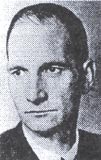
fig. 5 |
evident examples of nonsense
included in papers by e.g. Franz v. Wendrin who wrote about Germans
living in the Tertiary period, German king, Thorson who allegedly
had founded all cities in Poland already 200 000 years ago or
about Christ, the German king, or Ernst Petersen ( fig.
5) who claimed the Lech tribe on Silesia in Medieval Times
(Kostrzewski 1970, pp. 121, 187). It is worth remembering that
Józef Kostrzewski conducted the policy of Greater Poland that
was barely supported by the state government - on the contrary
to his German colleagues who had the full support of their state
authorities. |
An
exemplary archaeological site, the research results of which were
abused, was Biskupin
( fig. 6). The site was discovered in 1933
by Walenty Schweitzer and then researched for many years under
Kostrzewski's supervision ( fig. 7). The
research was accompanied by propaganda, but as it seems now the
Biskupin propaganda was mostly about advertising the archaeology
in order to receive funds for further research and to show archaeology
as a serious discipline of science that is worth
of such support (fig. 8,
9). Moreover the promotion
of |

fig. 6 |

fig. 7 |
Biskupin together with an appropriate national
propaganda (identifying the Lusatian culture with ethnos - the
Slavic ancestors) met the social demand and efficiently popularized
the archaeology as a scientific discipline and this was what the
Polish archaeologists needed at that time. Archaeology gave Greater
Poles, tired with the over-hundred fighting against Germanization,
a feeling of stability - we have been here for ages; not only
for the last one and a half thousands years, but "for ever". In
exchange for the subsidies the authorities expected some "practical"
results, so when Kostrzewski filed with the National Culture Fund
for a subsidy for works in Biskupin, he supported his request
as "refuting the unjustified claims of the German scientists concerning
the ethnographical relations in prehistoric Poland on the basis
of which The German scientists attempted to question Greater Poland
belonging to the Polish state" (UAM A-969). |
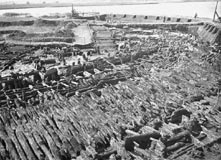
fig. 8 |
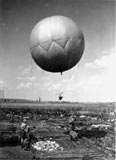
fig. 9 |
| 3.1. Science as politicians' servant |
In
1939 Germany attacked Poland and thus began World War II. In result
of some military activity Greater Poland was annexed to Germany
as Warthegau, although the borders between the Old and New Germany.
Scientific and cultural institutions were taken over by German
authorities that staffed them with Germans. Poles could work in
them only at the lowest posts - as cleaning persons, janitors
or drivers. The Wielkopolskie Museum regained its original name:
Kaiser Friedrich Museum.
The occupation of Poland
by the German army closed a particular stage in the history of
Germany. The German society frustrated with losing WWI and many
territories as the result of the war, and also with the later
economical crisis, began in the thirties to listen to nationalistic
slogans with attention greater than whenever and wherever before.
According to Adolf Hitler, Slavs as the "inferior people" on the
territory of Germany may at best serve the other and outside they
were allowed to manage by themselves, provided they recognize
the German superiority.
When founding the grounds
for their ideology, national socialists also took it down to prehistoric
times. Already on May 9, 1933 the interior minister, dr. Trick
stated that "the prehistory plays a prime role in teaching, as
it takes the beginnings of the Central-European cradle of the
German nation back in time; it is a superbly national discipline
of science" (Kostrzewski 1934, pp. 57-60). And this is how the
archaeology was boiled down to proving "scientifically" the superiority
of the "German race" over other races. The strong political stream
present in the German archaeology already from the 19th century
fostered the popularization of the national socialism among archaeologists,
all the more because after Hitler came to power, he offered jobs
to all unemployed prehistorians, provided they joined NSDAP, SS
or at least Deutsche Arbeitsfront. In the Scientific archive MAP
a prewar film commentary can be found reading, "inequality of
human races is an order intended by the God. As the contemporary
society aims at selecting the races, there is an obligation to
examine which anthropological and psychological features characterize
the German race. (
) The Northern races left some unforgettable
traces of their high culture, language, management abilities,
political and leadership talents". (
) Settled at first by Germans
(Goths, Burgunds and Vandals), lands in the east were left by
these tribes in the period of migration movements. (
) After the
Slavs entered the abandoned lands, Germans were trying to make
up the losses for many centuries." Completion of this historical
mission fell to the lot of the national socialists (MAP A-dz-52/5).
Before the outbreak
of the war, archaeologists were prepared for plundering any cultural
goods on the territories intended for conquering, and for an ideological
war. SS supervised all the activities by means of organizing special
excavation divisions and units designated for looting architectural
monuments on the conquered lands, and many others. An institution
called Ahnenerbe RFSS directed by A. Rosenberg played a vital
role. It organized offices that were responsible for taking the
possession of cultural goods on conquered territories for the
benefit of the Reich and for steering the cultural politics and
managing various cultural institutions. Each time Germans invaded
a country, in the second front line there were SS divisions specializing
in confiscating any historical objects and other valuable items,
accompanied by workers of the Trust Office assigned to administer
the conquered territory. |
| 3.2. Wielkopolska under the Nazi Occupation |
It
was not much different in case of Poland. In Poznań the German
Landeshauptmann took over the Prehistoric Division of the Wielkopolskie
Museum, renamed to Kaiser Friedrich Museum. Its Polish employers
lost their jobs or decided to leave them out of caution. Taken
over were also all buildings of the university. In the end of
1939 professor Hans Schleiff came to Poznań who was appointed
Der Generaltreuhändler für die Sicherstellung deutschen Kulturgutes
in den ehemals polnischen Gebieten, Treuhandstelle Posen (the
main administrator for matters related to securing German cultural
goods on the former territory of Poland; administrative center
in Poznań). He drew up a project for planned plundering of cultural
goods and for introducing new structures to museum management
and historical sites and objects protection. In keeping with the
project's guidelines in 1940 the Prehistoric Department was turned
into an office. It was called Landesamt für Vorgeschichte (LfV)
and carried out conservatory services and excavation works. It
supervised its affiliates among others in Łódź and Kalisz. The
office's main assignment for the years to come was to "Germanize
the collections" which should be understood as organizing them
according to some applicable German regulations. The post of the
Monuments Conservator was appointed, and when in 1941 the Reichsuniversität
was founded, Professor Ernst Petersen ( fig.
5) directed the prehistoric department.
In 1940 Freiherr Wolf
von Seefeld ( fig. 10) was employed in
the LfV. On November 5, 1940 Walter Kersten ( fig.
11), "an old comrade" who took care of Rhineland, Saxony and
Greece, became the director of LfV, which was strictly dependent
on the authorities of Warthegau. Among other archaeologists employed
in LfV worth mentioning were Günter Thärigen and Elisabeth Schlicht,
and an excavation technician Gustav Mazanetz. Some Poles were
employed there as well, including a few persons from Józef Kostrzewski's
staff - Władysław Maciejewski and Aleksander Waligórski. |
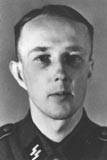
fig. 10 |
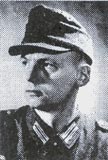
fig. 11 |
For
all German employees lesson of the Polish language were organized;
there are still class works available with propaganda texts for
translation (MAP A-dz-62/12). Due to the obligation to systematize
the materials no archeological research was planned other than
intervention works. The settlement of Biskupin was an exception
from this rule, the research of which was lead by an SS excavation
unit. A yearbook Posener Jahrbuch für Vorgeschichte was
founded, discoveries were exchanged so that they were stored at
the site of the discovery, and centralization of monuments and
books' collections was continued by means of plundering
the Polish resources. Al l documents,
the yearbook and press |
releases are simply full of propaganda
( fig. 12). The activity included: contacting
schools and organizations, guiding around the exhibitions, delivering
speeches and lectures, publishing results of archeological excavation
and intervention works in press. When in 1942 a reference book
on Poznań was released (Klock 1942, p. 5), the city was described
as the "uralten deutschen Vorburg im Osten" (ancient German
burg in the east). |
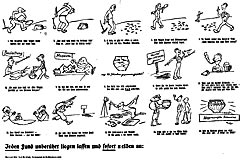
fig. 12 |
Another
assignment not related to a scientific research was an obligation
to write memoirs from war. The LfV workers who fought in the front
took down their experiences so they could be published in a special
"book of heroes". As the war extended in time and became truly
cruel, more "heroes" (MAP A-dz-47/5) had a chance to draft their
own picturesque stories. Memories of soldiers, full of vivid descriptions
of lice, ulcers, diseases, mud, vodka, museum, monuments and never-ending
victories were a source of admiration of men and women left at
the museum.
Another institution
that dealt with archaeology during the WWII was the Institut für
Vorgeschichte (opened on April 24, 1941). Professor Ernst Petersen
( fig. 5) was the manager, but his presence
there was only occasional as he occupied himself mainly with training
of the SS front divisions. A substitute teacher, Professor M.
Jahn from Wrocław, delivered lectures in the Institute instead.
After the death of Petersen in March 1944 Jahn became the head
of the prehistoric department. The Institute was busy finding
evidence of the "German nature" of Greater Poland, which can be
supported by some exemplary titles of lectures: Introduction
to early days of Warthegau, Migration of people and Vikings on
the territories to the east from the Elbe river, The culture of
facial urns and the Lusatian culture; the urns' holders fighting
for the German east. During a few operational years of the
Institute a dozen or so students learned there and in general
the Institute did not play any significant roles.
The German archaeologists
working in the war-time Poznań were mainly ardent advocates of
national socialism (surely with the exception of T. E. Haevernick).
In his letter to Kurt Langenheim, Walter Kersten ( fig.
11) expressed a belief that in Warthegau the Polish language
and Poles are doomed to extinction. Extermination or resettling
of Poles, although unpleasant, was entirely justified. Considering
himself a humanist, Kersten was prone to reach a compromise on
the territory of General Gubernia where only the intelligence
was to be exterminated and the living standard of poorly educated
people elevated so that they could be won for the national socialism
(MAP A-dz- 52/4). Kersten's remarks clearly show what the humanism
was about in the national-socialist version.
Until the beginning
of 1943 the archaeologists' enthusiasm relating to military victories
remained immense. "I was in Słupca
We are going to celebrate
the peace there (I hope)" - (MAP-A-dz-47/5) this is how on August
31, 1942 Kersten made an appointment with W. von Seefeld, at that
time in the front (Kersten died on April 7, 1944 south of Psków:
MAP-A-dz-47/1). In 1944 in the Poznań LfV there were only women
and Poles left, and the employees received no leaves and participated
in self-defense, sanitary, fire-protection and many other courses.
The affiliates in Łódź and Kalisz were closed, but the intervention
works were still carried out. In the end of 1944 some LfV workers
attempted to leave Poznań and head for the west (MAP A-dz-49/3),
majority however evacuated with other officials in the beginning
of 1945. Already in mid-December 1944 the premises of LfV were
taken over by uniform service Waffen SS and the soldiers staying
there ended up destroying partly the buildings and collections
(Kostrzewski 1970, pp. 249-250). |
| 4. The decay of World War Two |
The
war was finally finished but the consequences were disastrous
not only for German archaeologists, but mainly for Polish ones.
Gone were the followers of Józef Kostrzewski: Jacek Delekta (died
in Oświęcim), Zdzisław Durczewski (murdered in Warsaw), and his
students: Szubert (killed in 1939), Wydra (killed in the Warsaw
Uprising), Łukasiewicz (died in Oświęcim) and others including
one of Kostrzewski's sons. When all Polish archaeologists are
counted that were professionally active in the prewar period,
one fourth of them did not survive the war (11 persons); the next
7 did not return to the country.
In order to defeat Hitler,
the anti-Hitler coalition was forced to enter into an alliance
with Stalin. In 1944 it was clearly visible that it was mainly
Stalin who would decide about the future of the Central and Eastern
Europe. Due to Stalin's intervention Poland as the only state
of the anti-Hitler coalition lost a considerable part of land
in the East. In the end on the Jalta and Potsdam Conferences it
was determined that the loss would be compensated with some territory
along the Oder and the Lusatian Nysa including Szczecin and with
a part of Eastern Prussia. Nevertheless the territory of Poland
was decreased and it by as much as one fourth. Pursuant to the
decision by the anti-Hitler coalition Germans were resettled from
the territories awarded to Poland and from Sudety Mountains within
the borders of Czecho-Slovakia. Poles from the Eastern parts of
the country taken from Poland could leave for Poland and then
they were settled on the newly annexed lands in the West and North.
For many years to follow, the re-settlers lived with a conviction
of a personal injustice. Many Germans demanded a few times the
borders to be revised - and this according to the state of year
1937. |
| 5. The activity of Polish researchers |
| 5.1. The Institute for Western Affairs |
Already
in 1944, being aware of the planned territorial changes, a group
of Polish scientists coming from different regions (including
Greater Poland) who stayed in Kraków under compulsion specified
a goal for themselves. They wanted to prepare a scientific background
for these changes and to make the Polish citizens aware of their
rights to these territories. In December 1944 historians: Zygmunt
Wojciechowski, Maria Kiełczewska and Jan Zdzitowiecki founded
the Institute for Western Affairs, which was a research and development
station focused on the entire aspect of Polish-German relations.
Following the liberation, Poznań was supposed to be its place
of residence as the most natural environment due to its traditions
and geographical location (Bilans I roku
1946, pp. 291-295, Z
życia IZ 1947, pp. 362-376, Pollak 1955, pp. 469-472). Having
received the Prime Minister's approval in February 1945, the Institute
started its legitimate operation (Bilans I roku
1946, pp. 291-295).
Its charter read: "The aim of the Institute is to examine the
integral relations between Slavic countries, and particularly
Poland, with Germany; their course, lands that constitute their
territories and peoples living there". The Institute aimed at
providing Polish schools and society with necessary material -
decent and honest information about the Polish origins of recently
recovered lands (Bilans I roku
1946, pp. 291-295). In its first
years the Institute incorporated also the archaeologists. On May
12-18, 1947 in Osieczna an informative course on the Recovered
Lands took place for educational workers from the Western and
Northern Poland. W. Hensel delivered a speech there (Z życia IZ
1947, p. 586) on the ancient times of the lands. Generally, all
the numerous papers published by the Institute for Western Affairs
were to make Poles more familiar with the Recovered Lands, which
was the case with a linguistic paper by Lehr-Spławiński "About
the origins and prehistoric father land of Slavs" (Bilans I roku
1946, pp. 291-295) or a paper by Kostrzewski "Pre-Polish culture". |
The
Institute for Western Affairs was not the only institution concerned
with integrating the western lands with the rest of Poland. Having
returned to Poznań already on March 3, 1945 (Kostrzewski 1970,
pp. 245-246), Kostrzewski immediately got down to reconstructing
the Poznań archaeology. At first he occupied himself with renovating
the building of the museum and with recovering various collections
taken away to towns around Greater Poland but also to a salt mine
in Grassleben in Brunswick. On the other hand being almost entirely
destructed, the University Institute of Prehistory had to start
from the beginning. Kostrzewski developed a vivid style of work,
focusing on three main tasks: reconstruction of archeological
institutions, obligations of a conservator, and participation
in site planning of the Recovered Lands. The Museum remained independent
- it was now called Prehistoric. The museum building became home
also to two university departments: the Institute of Prehistory
and the Institute for Slav Antiquity Research in operation between
1945 and 1950. The later took over the excavation works in Biskupin.
In 1945 the Polish Prehistoric Society was reactivated.
Having assumed that
all archeological monuments are "ours" irrespective of the nationality,
which was a type of thinking characteristic to the Poznań archaeologists
already in the 19th century, in the first postwar years Józef
Kostrzewski took under his conservator's wings the territory of
the then Poznań province which covered areas up to the Oder and
the West Pomerania. He was mostly interested in "rubbled museums"
and mansions left behind by Germans that were constantly robbed.
And so he took all that to Poznań, declaring a return as soon
as new, appropriately staffed museums are founded in Pomerania
(MAP A-dz-80/3). Naturally it was only possible for a small part
of all collections - Stafiński, a coworker of Kostrzewski, estimated
that 70% of regional museums collections were stolen or destroyed
by newcomers (MAP A-dz-80/3).
The third field of Professor's
activity covered his participation in the cultural planning for
the "Recovered Lands". Apart from the salvation action, the director
of the Prehistoric Museum launched a popularization program on
prehistoric times of Greater Poland and the Recovered Lands. His
first lecture on the archaeology of Pomerania (PAN A-JK-106) he
delivered already in April 1945. Next lectures followed and the
Prehistoric Museum organized temporary exhibitions on prehistoric
times of Lubuskie Land (MAP A-dz-80/2). In 1945 the castle in
Poznań presented archaeology on an exhibition organized by the
Polish Western Society, Poznań District, which was devoted to
the fight against the German rule and which showed the Western
Lands (MAP A-dz-82/1). On the turn of February 1946 the Wielkopolskie
Museum organized a series of lectures on prehistoric times of
Slavic nations and Poland (MAP A-dz-80/1). Moreover, cooperation
developed with such institutions and organizations as provincial
governments, forest inspectorates, local units of information
and propaganda and the Monuments Protection Department. In 1946
Professor Kostrzewski cooperated with the Editors of the Polish
Atlas residing at the Measurements Main Office. The Editors were
preparing the so-called small atlas in relation to the Peace Conference
(MAP A-dz-82/3).
Naturally, as years
passed by, the stress put on fighting against Germans became weaker
and the celebrations related to 1000 years of the Polish state
became more significant (the anniversary was in 1966). Poland
fell within the reach of the Soviet Union's policy, which for
humanities meant nothing else but introducing Marxism as the methodological
basis. On no account was Kostrzewski able to popularize Marxism,
so in spite of the entire recognition the authorities had for
his Pre-Slavic theory, he was made to retire from the university
but remained the director of the Museum. In reaction to attempts
to centralize the archaeology and to transferring the control
center to Warsaw as well as establishing the German Democratic
Republic, the Poznań-German polemics became weaker and when they
happened, they were always approved by Warsaw. Therefore as it
seems to the authors of this paper, the main stream of Poznań
habitants fighting for the western lands ended rather in the beginning
of the 1950s and not in 1956. |
When
in polemics with German archaeologists, Józef Kostrzewski applied
a similar style and the same ethnographical method, but the sense
was different.
Kossina dared to use
such statements as: "For Germans, who always, and even more in
a time of war, have a strong desire of law and order, they [Slavs]
were just objects of abhorrence and atrocity" (Kostrzewski 1970,
pp. 154-155). At the same time Kostrzewski would compare migration
of Germans to the movement of Gypsies (Kostrzewski 1970, p. 155)
- a comparison seemed offensive to Germans but only because of
their belief in the race theories fashionable at that time. Professor
also reminded that although there is a German minority in Poznań,
it does not signify that it is a German country, to the same extent
as the German Westfalia cannot be Polish only because a quarter
of a million of Poles live there (Kostrzewski 1970, p. 113).
Both Poles and Germans
were legitimate to express their opinion on lands with mixed ethnic
origins such as Silesia or Pomerania. No wonder both sides reached
to historical arguments, however those were possible to prove
only as far in the past as by medieval times. When research is
made deeper in time, where reconstruction of the past is only
hypothetical, conclusions are already abusing the rules of science.
When a side to a dispute presents racial arguments to support
extermination of a particular group of people, we can call it
a crime.
In case of Kostrzewski
we talk about using the hypothesis about the Preslavic origins
of the Lusatian culture to support the rights to land, and this
only in journalistic and not strictly scientific texts. The style
of his argumentation was strongly influenced by his explosive
temper, which resulted in numerous arbitration commissions and
court cases where he was either the insulting or the insulted
party. The main goal of the Polish-German polemics was to prove
the rights to the disputable lands that "always were and will
be ours". Kostrzewski had an easier task here as without any trouble
he could show that Poles and not Germans were first to live on
the territory of both Silesia and Pomerania. In the end it was
the politics and not history that decided about the shape of borders
of our countries.
In one more thing Germans
and Poles could not agree. When the German scientists put forward
a hypothesis about historical rights of Germans to Greater Poland,
after a few dozens of years all graduates from German elementary
schools in the Poznań province knew that they live on the piece
of land that historically could belong to them. After the war
attempts were made to teach some prehistory in Polish schools,
but not for too long. Connections between Poland and the Recovered
Lands were convincing only to those settlers who came from Greater
Poland. For families coming from the east the Masurians and Silesians
who spoke a dialect filled with German vocabulary were the "natives",
understood as Germans, a strange element. Misunderstandings between
the two groups lead to emigration of many natives.
Recently the concept
of Pre-Slavic origins developed by Józef Kostrzewski is being
criticized ever stronger, particularly by the Polish archaeologists
majoring in the period of Roman influences. However, the opponents
have not developed their own research method but returned to the
classic methods of Gustav Kossinna, also in terms of the style
of vivid polemics with skeptics who doubt in the possibility to
specify the ethnos of the archeological culture exclusively on
the basis of discovered objects. And so the mystery of the Slavs'
origin is still waiting for new concepts. |
Bilans I roku
1946 Bilans I roku pracy Instytutu Zachodniego. Sprawozdanie dyrekcji złożone na walnym zebraniu członków w dniu 16 marca br., Przegląd Zachodni, t. I, s. 291-298
Jakóbczyk W. (red.)
1998 Dzieje Poznania: lata 1793 - 1918, t. 2, cz. 2, Warszawa
Grześ, B., Kozłowski, J., Kramski, A.
1976 Niemcy w Poznańskiem wobec polityki germanizacyjnej 1815-1920, Poznań
Kaczmarek, J.
1996 Organizacja badań i ochrony zabytków archeologicznych w Poznaniu (1720-1958), Poznań
Klock, E.
1942 Posen, Chronik der Gauhaupstadt Posen, Posen
Kostrzewski, J.
1914 Wielkopolska w czasach przedhistorycznych, Poznań
1919 Die ostgermanische Kultur der Spätlatenezeit, Mannus Bibliothek
nr 18 i 19,
Lepipzig, Würzburg
b.r.w. (po 1930) Początki kultury ludzkiej, Poznań
1930 Vorgeschichtsforschung und Politik. Eine Antwort auf die
Flugschrift von Dr.Bolko
Frh. von Richthofen: Gehört Ostdeutschland zur Urheimat der Polen,
[Poznań?]
1934 Historiografia hitlerowska a prehistoryczna teoria Kossiny,
Z Otchłani Wieków,
R. IX, s. 57-62
1946 Gospodarka niemiecka w Poznańskim Muzeum Prehistorycznym,
Z Otchłani
Wieków, R. XV, s. 4-9
1970 Z mego życia, Wrocław-Warszawa-Kraków
Nowa
1996 Nowa Encyklopedia Powszechna PWN, t. 4, Warszawa
Piotrowska, D.
1997-1998 Biskupin 1933-1996: archaeology, politics and nationalism,
Archaeologia
Polona, vol. 35-36, s. 255-285
Pollak, M.
1955 Instytut Zachodni. Powstanie i rozwój organizacyjny,
Przegląd Zachodni, R. XI,
t. 1, s. 469-486
Rączkowski, W.
2003 Expansion and reaction: The concept of Polish Archaeology
in the discourse
with German archaeologists (referat wygłoszony na konferencji
Area_III:
"Archaeology, expansion, resistance"), Poznań, 12 czerwiec 2003
r.
Rohrer, W.
2003 Archäologie und Propaganda. Die Ur- und Frühgeschichte von
1918 bis 1933.
Bespiel Schlesien, Berlin, (maszynopis pracy magisterskiej)
2003 Science between propaganda and polemics archaeology in Upper
Silesia 1918
to 1933 (referat przygotowany do publikacji w czasopiśmie Archaeologia
Polona)
Tacyt,
1957 De origine et situ Germanorum [w:] Dzieła, t. II, Warszawar
Z życia IZ
1947 Z życia Instytutu Zachodniego, Przegląd Zachodni, t. I, II s. 360-377, 586-588
|
| Consecutive numbers of the documents used in paper: |
|


